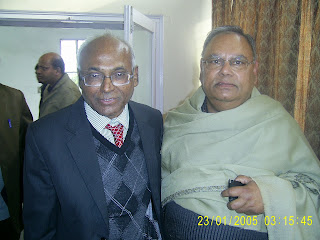Dr. B.R. Ambedkar, you may be surprised to know, was not as
acceptable even in the late 60s as he is today. The Congress Party and its
opposition to Ambedkar were vehement and telling. But at the same time Dr.
Ambedkar’s influence among the dalits was taking roots slowly but steadily in
Punjab. Republican Party was at the vanguard under the leadership of Duni Chand
Shahpuri, Piara Ram Dhanowali, Charan Dass Nidhadak, Lahori Ram Balley and
others. The Bheem Patrika edited by Lahori Ram Balley was the mouth piece of
the Republican Party and the followers of Ambedkar. The finances were scarce
and tight. No Government patronage was available to the name and memory of
Ambedkar. Ambedkar’s followers under the
flag of Republican Party planned and brought up the idea of Ambedkar Bhawan at
Nakodar Road, Jalandhar in the early 60s. A fairly good plot of land situated
between Abadpura and Bootan Mandi, the localities which are mostly inhabited by
dalits, were purchased. It is a
co-incident that it is located at the large chunk of open land where Dr.
Ambedkar addressed a mammoth public meeting in October 1952. The promoters
could not get enough financial back up and the project remained a piece of land
only till the early70s. But the name of Ambedkar has its latent force. A
follower of Ambedkar and a resident of Abadpura whose name, if I remember
correctly, was Ram Prakash, died under detention in a strong agitation of the
Republican Party against the Congress Government in 1964. It was decided to
cremate him at the plot of land acquired for the Ambedkar Bhawan. The place became a venue of regular public
meetings and get-togethers of the followers of Ambedkar particularly the
functions arranged by the Republican Party. I personally heard, in my younger
days, the national leaders of the Party like Dadasaheb B.K. Gaikwad, B.D.
Khobragade, B.P. Maurya and others speaking at the venue on different
occasions. But the health of the project was not very healthy.
In the mid 80s, fortunately, some new dedicated senior
retired officers like G.S. Bal, R.C. Paul, Surinder Ajnat, Nasib Chand and many
more, came forward and associated themselves with Ambedkar Bhawan under the
aegis of Ambedkar Mission society and Ambedkar Bhawan Trust. Lahori Ram Balley
provided them all help and continues till today actively engaged with the
project. The second lot of dedicated followers of Ambedkar like G.C. Kaul,
Tarsem Sagar, Ram Lal Jassi, Barkha Ram, and Chanan Ram took over and
successfully tried to raise the much needed funds to build a reasonably good
building by involving various political personalities including PM Inder Gujral
and others. It was a right approach as such projects required support of the
establishment in addition to the public. It is matter of gratification to note
that now there is fairly good and functional building and facilities at the
venue. Ambedkar Bhawan could become a nerve centre of the community activities
and also for the mission and philosophy of Dr. B.R. Ambedkar.
Over the last one year, I attended two impressive functions
at the Bhawan to pay tributes to the memory of Dr. Ambedkar on December 6, 2011
and December 6, 2012 on the Parinirvan Diwas ( death anniversary of Dr.
Ambedkar respectively. At the first function, MP Mohinder Singh Kaypee provided
a good sum of grant for the project out of the MP; s fund. It was an
appreciable gesture. More needs to be done. This year on December 6, renowned
scholar Kancha Illiaha was the chief guest and lead speaker. He spoke with
conviction and paid glowing tributes to Dr. Ambedkar, the greatest son of India
since independence. Lahori Ram Balley and R.P.S. Pawar who is the current
chairman of the Ambedkar Bhawan Trust, inter alia, spoke at the function which
was fairly well attended. Ambedkar deserves wider recognition which is coming
but slowly in the caste ridden and discriminatory social order.
I wish the Ambedkar Bhawan Trust all success in the years to
come.





















